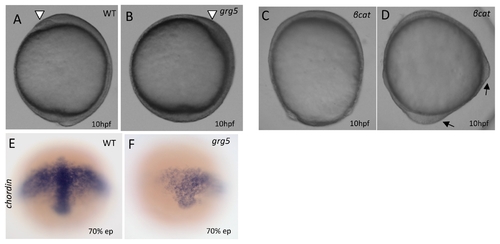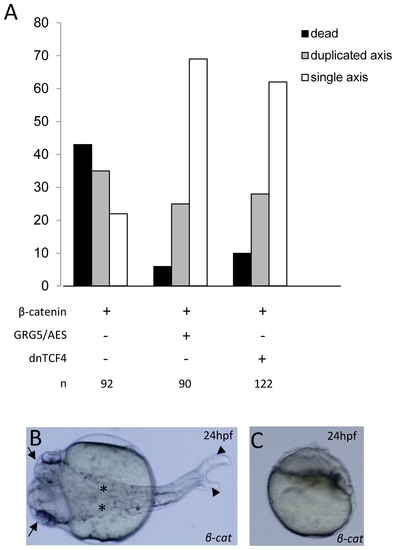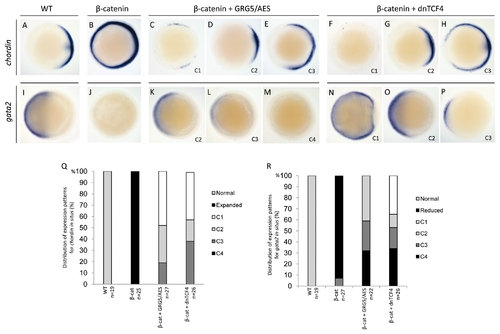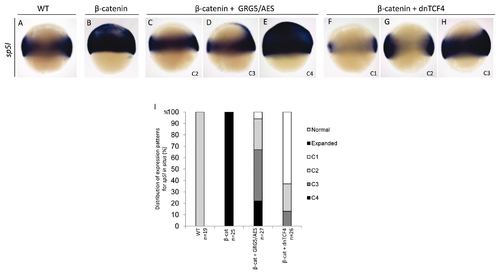- Title
-
GRG5/AES Interacts with T-Cell Factor 4 (TCF4) and Downregulates Wnt Signaling in Human Cells and Zebrafish Embryos
- Authors
- Costa, A.M., Pereira-Castro, I., Ricardo, E., Spencer, F., Fisher, S., and da Costa, L.T.
- Source
- Full text @ PLoS One
|
GRG5/AES overexpression leads to ventralization of zebrafish embryos. (A–D) Lateral view, dorsal to the right, of 10hpf-stage embryos. (A) Control uninjected; (B) Injected with 250pg of grg5/aes mRNA; arrowhead: anterior end of the neural plate with formation of the “polster” in the prospective head region; (C–D) Injected with 100pg of an activated β-catenin mRNA. Black arrows: ectopic dorsal axis; E-F) Whole-mount in situ hybridization for chordin expression at 70% epiboly uninjected (E) and grg5/aes-injected (F) embryos. EXPRESSION / LABELING:
|
|
GRG5/AES reduces both mortality and axis duplication in β-catenin-overexpressing embryos. A) One blastomere of 8-cell stage zebrafish embryos was injected with the indicated combinations of β-catenin (50 pg), grg5/aes (500 pg) and dntcf4 (500 pg) mRNAs. Partial and complete axis duplications were grouped to avoid ambiguity. The total number of scored embryos (n) is indicated at the lower part of the panel. B) Example of 24hpf embryo showing complete axis duplication (induced by β-catenin injection), with two discernible heads (arrows), notochords (asterisks) and tails (arrowheads). Dorsal view, anterior to the left. C) Example of 24hpf embryo injected with β-catenin showing extreme dorsalization. |
|
GRG5/AES antagonizes β-catenin in dorsal-ventral patterning during early zebrafish embryogenesis. Whole-mount in situ hybridizations for chordin (A–H) and gata2 (I–P) of double-injection experiments (columns). Animal pole views, dorsal to the right, of 70% epiboly stage-embryos. Injection of β-catenin strongly dorsalizes embryos, as shown by an expanded and circumferential expression of the dorsal-specific gene chordin (B) and a total absence of the ventral-specific gene gata2 (J). Co-injection of grg5/aes (C-E; K-M) rescues β-catenin-induced dorsalization and restores normal expression domains for both marker genes. dntcf4 co-injections (F–H; N–P) were used as a control for β-catenin antagonism. Co-injected embryos were grouped in four classes of marker gene expression: C1 (C, F) – abnormal expression consistent with embryo ventralization; C2 (D, G; K,O) restoration of normal expression patterns (A,I); C3 (E, H; L, P) – partial reversion of β-catenin-induced abnormalities; C4 (M) abnormal expression consistent with embryo dorsalization. Q–R: distribution of the embryos in the different classes of chordin (Q) and gata2 (R) expression. GRG5/AES antagonizes β-catenin effects on chordin and gata2 in 100% and 68% of the embryos respectively. n: number of embryos tested. EXPRESSION / LABELING:
|
|
GRG5/AES represses Wnt signaling during early zebrafish embryogenesis. Whole-mount in situ hybridizations for sp5l, a direct target of canonical Wnt signaling. Lateral view, dorsal to the right, of 70% epiboly stage-embryos. Injection of β-catenin induces broad ectopic domains of sp5l expression (B), which are reversed by co-injection of grg5/aes (C–E) or dntcf4 (F–H). Expression patterns in co-injected embryos were grouped in four classes, as above. AES reversed β-catenin-induced misexpression in 75% of the embryos (I). n: number of embryos tested. |




